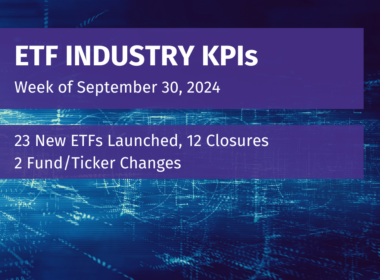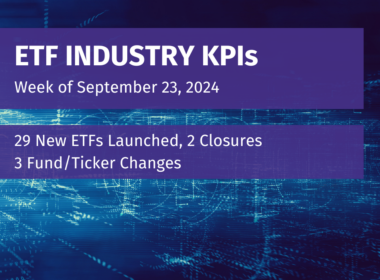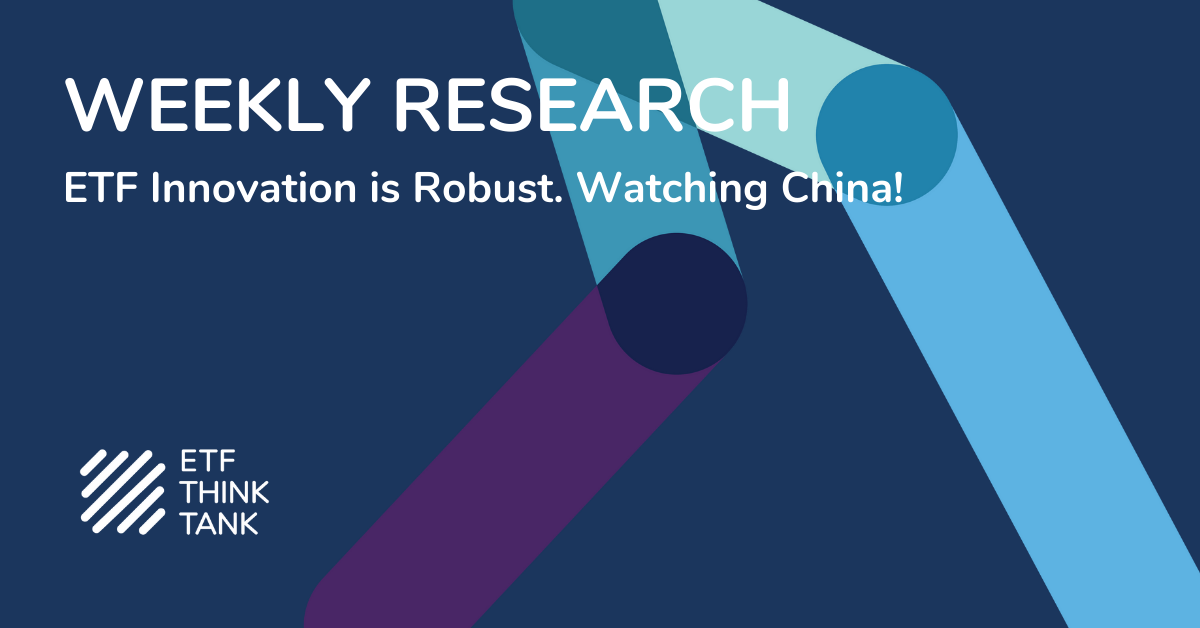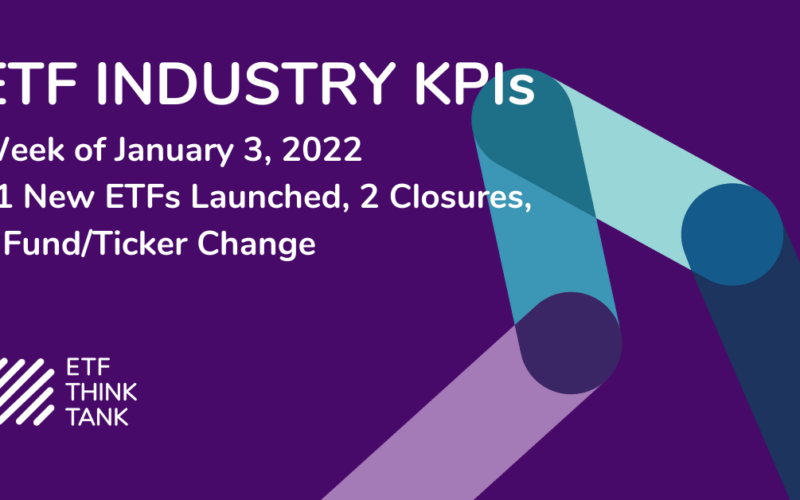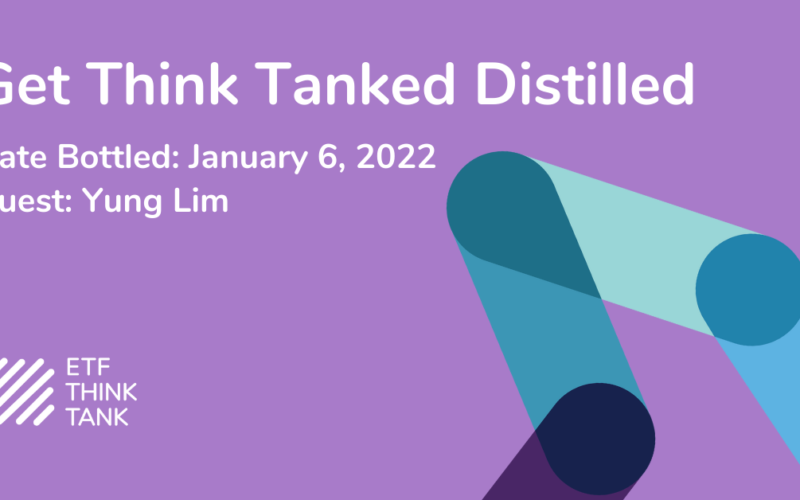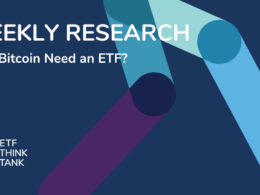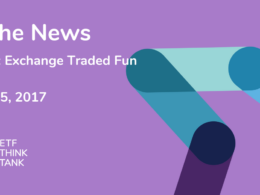Following up from the ETF Think Tank Blog Post last week, titled “2021 Was Great For ETFs,” we bring the concept full circle to make three key points:
- Innovation is alive and well despite fee compression.
- Index construction is mostly driven by the sponsor of the ETF.
- China: anything but passive!
Innovation is Alive and Well Despite Fee Compression
We believe that innovation is alive and well in the ETF industry, despite what Eric Balchunas cites in his soon to be released book “The Bogle Effect” (April 2022 Pre-Order) as the “Scariest Chart in the Asset Management” industry. Eric is, of course, correct about the dominance felt by the massive investment scale of the Vanguard machine. However, we would highlight that the scary chart masks the fact that innovation is accelerating in the ETF industry, and this is an area that Vanguard is not strong in. We are working on an update to the 2020 blog piece “Measuring Innovation in the ETF Industry”which addresses growth metrics since 2009, but for now we would highlight that market share in overall Assets Under Management (AUM) and Revenues in the traditional broad funds are showing signs of leakage in terms of market share dominance. Since December 31, 2018, growth of AUM in the ETF industry has increased about 48%, and the market share of AUM by Traditional has declined from 70.73% to 63.69%. Market share of aggregate industry revenues, as measured by expense ratios, has declined from 58.52% to 47.56%. In the ETF Think Tank, we see active ETF revenues eclipsing 10% of the industry revenues in 2022 but appreciate that fees earned by active funds are more dependent on short term performance than traditional passive strategies.

The power of innovation is driven by offering outperformance through thematic investing and filling a void where there is demand that solves a core or fundamental problem (aka inflation and ESG). Whether growth comes in the form of non-traditional indexes or active is less important, but it is evident that fees can be overcome where value is deliberate and clear. This can be seen clearly in the chart below, which highlights that when ER ETF 12 Month Revenues for Active and Non-Traditional now represent revenue market share of over 52.44%, up from 41.49% 3 years ago. This sheds some new light on the long-time debate of Passive vs Active & Non-Traditional.

Structure Matters: Index Construction is mostly Driven by the Sponsor of an ETF
The number of ETFs during this same period only grew 34% after an awesome 2021 (open 459/closed 100) and an awful 2020 (open 276/closed 286). Remember – no one ever launched an ETF that they thought would fail. We therefore argue that in periods of time where closures are high, innovation can still have momentum, as stale products are replaced by more timely offerings.
We have wonderfully deep due diligence discussions in the ETF Think Tank that are designed to engage with ETF innovation. As a reminder, such discussions involve ETF issuers and financial advisors looking to brainstorm ETF product positing, portfolio construction and risk controls. In 2021 we hosted over 500 such calls. We host these calls to help challenge traditional thinking and better understand newer, innovative ETF ideas. As ETF nerds, we like to consider ourselves out-of-the-box thinkers that seek to address current investment and business issues with financial advisors as well as issuers. To this point, last week we also ended up taking a step back during a call about the developmental process of building index. Talking about the core meaning of Structure Matters! Of course, this is especially true in terms of ESG construction, and even around the basic question of whether all sponsors vote their proxies. The ironic point here is the fact that not all index providers are the same, even though the business would appear to be highly commoditized. Similarly, we discussed how important a good index provider is to an issuer who is driven by the creative process to build an alpha-generating solution. It is for this reason that some firms like WisdomTree are fully integrated rather than using a name brand like S&P Dow Jones, MSCI or FTSE Russell, and why smaller firms like MVIS, Solactive and S-Network Global Index exist. For more information, please reach out to us.
China: Anything but Passive
For those who are curious about taking risk on China, you might be surprised to find that there are 55 choices across $36.05 billion, and only about 20 are above the $100 million mark. We bring up China because we hope that people remain vigilant with the elephant in the room for client portfolios. An obvious wild card surprise for 2022 would be for China to do something very impactful to global economies and markets. Alpha is often a driver for ETF AUM flows, but “price discovery” also works, since investors can size their positions easily and scale in without taking systemic risk. Often, this is the reason why passive funds work well in situations like China. KWEB, which according to Bloomberg raised $7.95 billion last year which is greater than its $7.2 billion market value, is a remarkable example of this. Note that YTD in 2022 $491 million flowed further into KWEB. However, it is noteworthy that there are 4 funds which are actively managed out of the 55 choices. Clearly, KraneShares dominates the opportunity set with the most offerings. We would expect 2022 to be a year where China exposure can have major diverging patterns. In 2021, it may surprise readers to learn that the best performing funds were involved in Environment (KGRN), China A shares, and a little-know, actively managed fund with the symbol RAYC. Speaking of Active – note this week on Thursday we have the controversial hedge fund manager Kyle Bass of Hayman Capital during our 5pm Happy Hour. Agree or disagree – last time he was on our show he nailed it. Remember his comments about BABA. One week before the IPO of Alipay he said it would not happen.

Conclusion
ETF Innovation has accelerated the past 3 years, despite the dominance of Vanguard and fee compression. AUM growth in the ETF industry has increased about 48%, and the market share of AUM in Traditional has declined from 70.73% to 63.69%. Market share of aggregate industry revenues, as measured by expense ratios, has declined from 58.52% to 47.56%. Looking to launch an ETF? Talk to us about which index provider makes the most sense for you. Structure matters in that regard since the cultural fit is important. KraneShares is the dominate provider of ETFs focused on China, which ultimately will not be ignored due to its global economic importance. Investors who think they are on the sidelines with their exposure to China should continue with due diligence, as its impact will remain relevant to all portfolios – for better or worse.
Disclosure
All investments involve risk, including possible loss of principal.
The information provided here is for financial professionals only and should not be considered an individualized recommendation or personalized investment advice. The investment strategies mentioned here may not be suitable for everyone. Each investor needs to review an investment strategy for his or her own particular situation before making any investment decision.
All expressions of opinion are subject to change without notice in reaction to shifting market conditions. Data contained herein from third party providers is obtained from what are considered reliable sources. However, its accuracy, completeness or reliability cannot be guaranteed.
Examples provided are for illustrative purposes only and not intended to be reflective of results you can expect to achieve.
The value of investments and the income from them can go down as well as up and investors may not get back the amounts originally invested, and can be affected by changes in interest rates, in exchange rates, general market conditions, political, social and economic developments and other variable factors. Investment involves risks including but not limited to, possible delays in payments and loss of income or capital. Neither Toroso nor any of its affiliates guarantees any rate of return or the return of capital invested. This commentary material is available for informational purposes only and nothing herein constitutes an offer to sell or a solicitation of an offer to buy any security and nothing herein should be construed as such. All investment strategies and investments involve risk of loss, including the possible loss of all amounts invested, and nothing herein should be construed as a guarantee of any specific outcome or profit. While we have gathered the information presented herein from sources that we believe to be reliable, we cannot guarantee the accuracy or completeness of the information presented and the information presented should not be relied upon as such. Any opinions expressed herein are our opinions and are current only as of the date of distribution, and are subject to change without notice. We disclaim any obligation to provide revised opinions in the event of changed circumstances.
The information in this material is confidential and proprietary and may not be used other than by the intended user. Neither Toroso or its affiliates or any of their officers or employees of Toroso accepts any liability whatsoever for any loss arising from any use of this material or its contents. This material may not be reproduced, distributed or published without prior written permission from Toroso. Distribution of this material may be restricted in certain jurisdictions. Any persons coming into possession of this material should seek advice for details of and observe such restrictions (if any).




